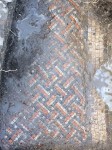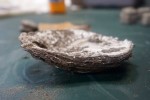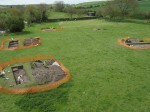 In February of 2015, rug designer Luke Irwin was converting a small barn on his southwest Wiltshire property into a ping-pong room for his very lucky children. Not wanting to mar the beautiful landscape with an overhead cable strung from the farmhouse to the bar, Irwin insisted electricians lay the cables for the future game room underground. When they dug the trench, they came across a flat, hard layer 18 inches under the surface. It was a red, white and blue mosaic in a geometric woven pattern known as guilloche.
In February of 2015, rug designer Luke Irwin was converting a small barn on his southwest Wiltshire property into a ping-pong room for his very lucky children. Not wanting to mar the beautiful landscape with an overhead cable strung from the farmhouse to the bar, Irwin insisted electricians lay the cables for the future game room underground. When they dug the trench, they came across a flat, hard layer 18 inches under the surface. It was a red, white and blue mosaic in a geometric woven pattern known as guilloche.
 Irwin took a picture of the mosaic and sent it to the Wiltshire Council. Within 24 hours, council archaeologists were on the spot. They identified the mosaic as a top quality Roman work of the kind you’d see only in the most expensive, important villas in Roman Britain. Geophysical survey of the site found that the mosaic was in the destroyed or collapsed wing of a large Roman villa. The gateway where the mosaic was found leads to the modern farmhouse and outbuildings which obviously cannot be excavated, but archaeologists believe they were built in the center of where the ancient villa once stood. The farmhouse stands on a slab of Purbeck marble that is likely of Roman origin.
Irwin took a picture of the mosaic and sent it to the Wiltshire Council. Within 24 hours, council archaeologists were on the spot. They identified the mosaic as a top quality Roman work of the kind you’d see only in the most expensive, important villas in Roman Britain. Geophysical survey of the site found that the mosaic was in the destroyed or collapsed wing of a large Roman villa. The gateway where the mosaic was found leads to the modern farmhouse and outbuildings which obviously cannot be excavated, but archaeologists believe they were built in the center of where the ancient villa once stood. The farmhouse stands on a slab of Purbeck marble that is likely of Roman origin.
 In April of 2015, the Wiltshire Archaeology Service, Salisbury Museum and Historic England worked together to dig a few test pits in key areas of the property. They were able to confirm that the villa was built between 175 an 220 A.D. and was regularly renovated through the mid-4th century. It was three storeys high with a footprint of at least 165 feet x 165 feet, and possibly as large as 230 by 230 feet. There’s evidence that it was pillaged in 360 A.D. only to be reoccupied in the 5th century.
In April of 2015, the Wiltshire Archaeology Service, Salisbury Museum and Historic England worked together to dig a few test pits in key areas of the property. They were able to confirm that the villa was built between 175 an 220 A.D. and was regularly renovated through the mid-4th century. It was three storeys high with a footprint of at least 165 feet x 165 feet, and possibly as large as 230 by 230 feet. There’s evidence that it was pillaged in 360 A.D. only to be reoccupied in the 5th century.
 Other artifacts discovered underscore how rich and important the owners of the villa were. There are hundreds of discarded oyster and whelk shells which would have been cultivated on the coast and been transported alive to Wiltshire from the coast in barrels of salt water. Archaeologists also found a Roman well in excellent condition, a bath house and, unassuming in the garden where it was used as a geranium planter, the stone coffin of a Roman child. There’s high status pottery, coins, brooches and copious animal bones both domestic and wild which bear the signs of butchering.
Other artifacts discovered underscore how rich and important the owners of the villa were. There are hundreds of discarded oyster and whelk shells which would have been cultivated on the coast and been transported alive to Wiltshire from the coast in barrels of salt water. Archaeologists also found a Roman well in excellent condition, a bath house and, unassuming in the garden where it was used as a geranium planter, the stone coffin of a Roman child. There’s high status pottery, coins, brooches and copious animal bones both domestic and wild which bear the signs of butchering.
Only a few test pits have been dug, but Roberts said it was clear the walls of the villa were probably still more than a metre high, although they are buried under alluvial sediment from a nearby river. In addition, the mosaic has been revealed to be of particularly high quality. “Everything about this villa suggests it was made of the highest-quality materials,” added Roberts. “We have identified bits of stone that have come from at least 13 different British quarries. This was the country house of a powerful, rich Roman. Doubtless he also had a city house in London or Cirencester.”
Intriguingly, the house was not destroyed after the collapse of the Roman empire, said [Historic England archaeologist Dr. David] Roberts. Archaeologists have discovered timber structures erected in the fifth century. Roberts said the remains from this period, between the end of Roman occupation and the completion of Saxon domination of England, could open a window into one of the least understood periods in British history. It could also reveal how people responded to the collapse of the Roman empire, the superpower of the age.
 Other than the construction of the labourers’ cottages that would be converted into the current farmhouse, the property has been left alone and undeveloped, used primarily as grazing land, since the villa was last inhabited in the 5th century. This gives archaeologists a unique opportunity to explore one of the largest Roman houses in Britain with little to no interference from later agriculture or construction. Dr. Roberts called the villa “unparalleled in recent years,” a “hugely valuable site in terms of research, with incredible potential,” and one of the best sites he has ever worked on.
Other than the construction of the labourers’ cottages that would be converted into the current farmhouse, the property has been left alone and undeveloped, used primarily as grazing land, since the villa was last inhabited in the 5th century. This gives archaeologists a unique opportunity to explore one of the largest Roman houses in Britain with little to no interference from later agriculture or construction. Dr. Roberts called the villa “unparalleled in recent years,” a “hugely valuable site in terms of research, with incredible potential,” and one of the best sites he has ever worked on.
And yet, the test pits have all been refilled and there are no current plans to further excavate this momentous find.
[Roberts] added: “Unfortunately, it would cost hundreds of thousands of pounds to fully excavate and the preserve the site, which cannot be done with the current pressures.
“We would very much like to go back and carry out more digs to further our understanding of the site. But it’s a question of raising the money and taking our time, because as with all archaeological work there is the risk of destroying the very thing you seek to uncover.”
The discovery of the villa has inspired Irwin to design a line of rugs with mosaic patterns. They even made rug tesserae, little cubes of hand-woven silk set between wool lines. I like how they’ve distressed the rugs so that have faded and “missing” areas like real ancient mosaics.
“..from the farmhouse [straight] to the bar.”
Every Friday in Wiltshire, ..”veni, vidi, Vini” in horreo (= the barN) ?!?
:hattip:
Anyone who wants to dig my back garden for Roman remains will be made welcome, so long as he promises to dig in plenty of compost, manure, and agricultural grit while he does it.
From my trips to England it appears to me that there is always the risk attached to planting a garden or installing a fence that you may dig up a Roman ruin or Iron Age grave! I can understand why they can’t afford to excavate them all, there would never be an end. One episode of Time Team had them discovering a large Roman Villa in Somerset. Great stuff!
Not only is this an amazing story, but those are the most beautiful rugs I have ever seen. Did you check out Ozymandias & Ockham’s Razor? Stunning!
This is another in a long series of stories that make me wish I lived in England. About the most interesting thing archaeologists could hope to find in my back yard is an old buffalo wallow.
Thanks, especially for the cool aerial photo!
If this is as important as it seems, perhaps the Getty Foundation would finance further professional digs. Not so?